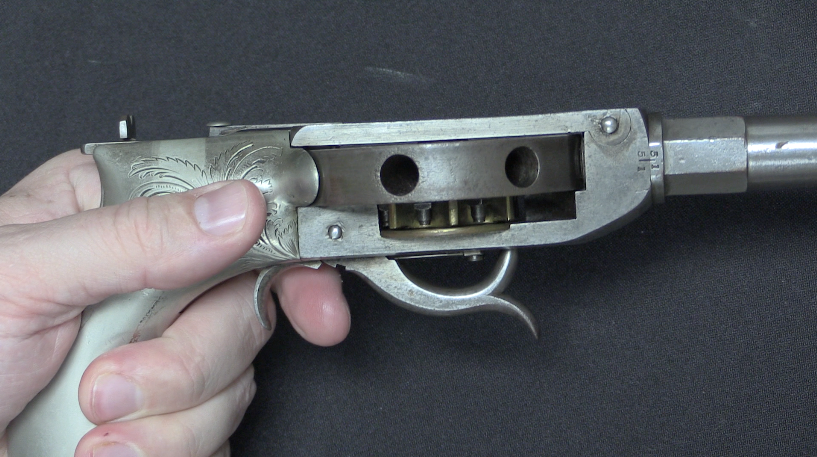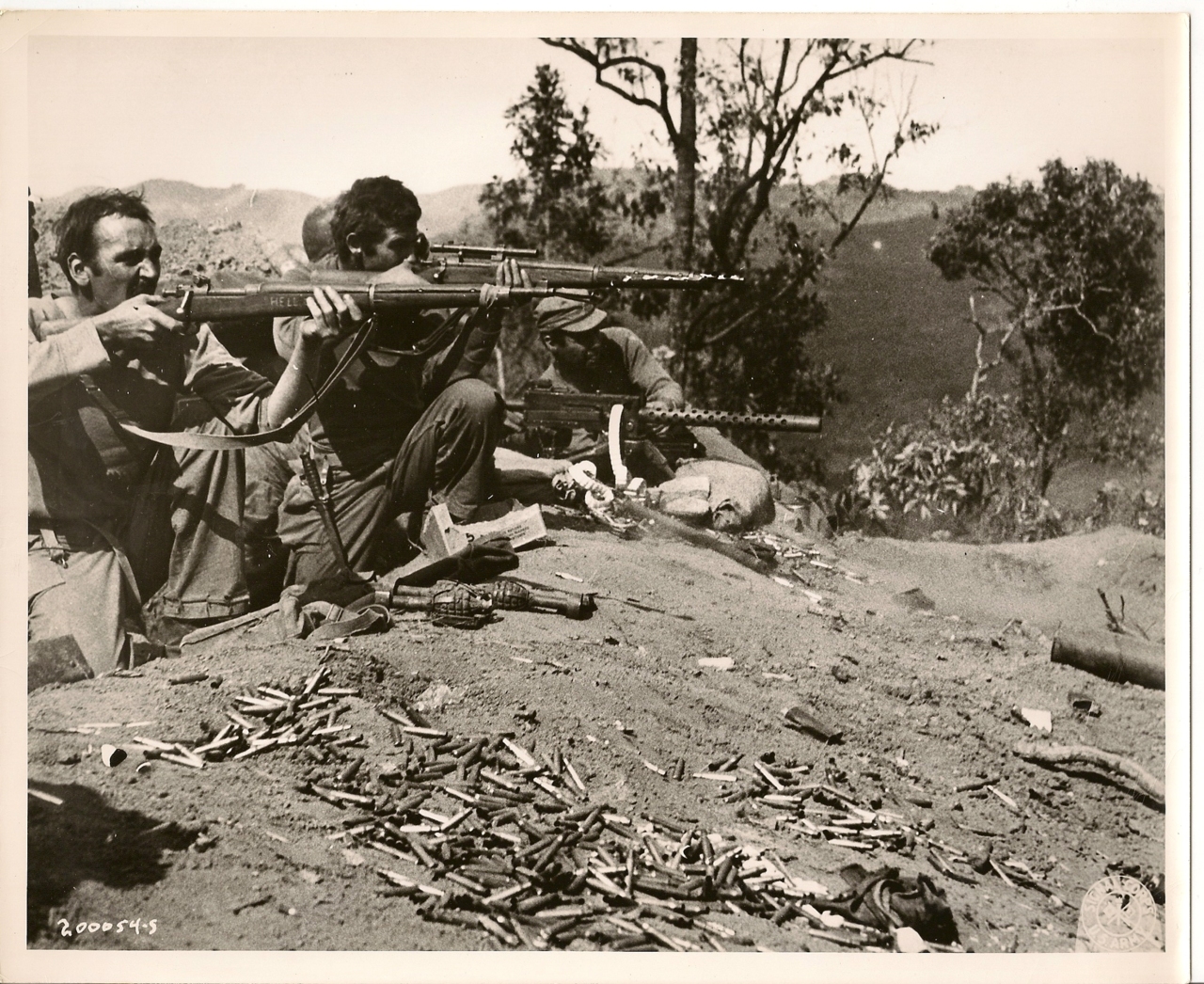As the self-contained metallic cartridge because popular, a niche industry developed in converting percussion revolvers to use the new cartridges. One of the first of these conversions was designed by F. Alexander Thuer and marketed by the Colt company itself. Thuer’s conversion was put into production while the Rollin White patent was still in force, and so it was prevented from using a bored-through cylinder. The get around this, Thuer developed his own proprietary centerfire cartridge with no rim and a very slight taper. These cartridges were loaded from the front of the cylinder and press-fit into place. While this made the conversion legal to sell commercially, it had a number of problems (in addition the use of proprietary ammunition) which led to it quickly losing favor as soon as White’s patent expired. This particular Thuer conversion is on an 1849 Colt Pocket revolver:
Related Articles

Revolver
RIA: Cochran Turret Revolver

Percussion
North & Skinner Revolving Rifle

Bolt Action Rifles

Wonder if tight fit cartridges remain their locations though inertia at instance of firing.
The Patent restriction lead to development many workarounds being alternative solutions of problems some were a fails (St. Etienne 1907 was IIRC designed to avoid patent infringement upon Hotchkiss machine-gun), some were just working (less or more) properly and some was superior to original patent.
When I seen front-loading cartridge revolver it reminds me Rikhter R-23 which is front-loading revolver-auto-cannon.
“Rollin White patent”
Wasn’t the pinfire revolver (which need bore-through cylinder) patented earlier in United States?
Yes, the French LeFaucheux patent was registered in the U.S. in 1852, three years before the Rollin White patent. And it specifically mentions the bored-through cylinder as being necessry, because of course it’s not practical to load a pinfire cartridge into the chamber from the front.
There was almost certainly some “hanky-panky” involved, as we discussed a few days ago on the thread about the Moore swingout cylinder/barrel 32.
BTW, Moore developed a revolver on the same principle as the Thuer in 1865. It use what was known as a “teat-fire” cartridge;
http://armscollectors.com/mgs/images/competition/mooreoverall.jpg
The rounded end with the little “peg” sticking out is the back end. The ‘peg’ is the ‘teat-fire’ primer, that projected through a hole in thwe slid back end of the chamber to be hit by the hammer like a regular percussion cap. The bullet is in the flat end, rather like a Russian Nagant except that this is not a “gas-seal” system.
The system is very similar to the Thuer overall, but simpler and probably less of a pain to work with.
cheers
eon
The “breech ring” of the Thuer is a complex beast because it has three functions. Firing, safety, and ejection. Ejection works like this;
The ring is moved all the way to the right past the firing position. Most have an “E” engraved at that point, that you line up with the hammer.
You then cock the hammer. When you pull the trigger, the hammer hits a second “snap-cap” that transmits the impact to one end of that lever Ian showed us. The other end overlaps the end of a second lever behind that leaf spring. (Think of two playground “teeter-totters” in line with each other, their ends overlapping.)
When the hammer hits the end of the first “teeter”, its other end whacks the near end of the second, forcing it backward (toward the butt). The opposite end of the second lever briskly smacks the rear end of the cartridge in the 3 o’clock position, as seen from the shooter’s POV, forcing it forward and supposedly ejecting it.
In fact, it rarely did more than move it about 1/4″ (5-6mm), thus requiring a tool to get it the rest of the way out.
The American Civil War Burnside and Gallagher single-shot carbines used metallic cartridges that worked on very much the same principle, being loaded backward into a breech recess. They were separately-primed, i.e. fired by a percussion cap, rather than centerfire.
The Gallagher cartridge looked a lot like the Thuer;
http://picturearchive.gunauction.com/1843214209/3692134/1222a.JPG
The Burnside looked more like an ice cream cone (no, really);
http://p2.la-img.com/1044/20374/6956245_1_l.jpg
That “ring” held lubricant. The Burnside had a nasty habit of tearing it off and sending it down the barrel with the bullet, leaving the rest of the case firmly stuck in the breech chamber.
Both Gallagher and Burnside carbines had part of the chamber in the barrel. The idea being that you could just pull the empty out with your fingers. The Burnside ripped the front part of the case off as described. The Gallagher just tended to blow the case in two at the joint, leaving half of it stuck in each section of the chamber.
Both came with “combination tools” that had a sort of wrench to help remove stuck cases. Neither one was much help.
The Smith carbine had a similar setup. But it used an India rubber cartridge case. It apparently worked better, but after a few rounds it must have smelled a bit peculiar.
The similarity of the Thuer conversion to the Gallagher and Burnside makes me wonder if F. Alexander Thuer didn’t work on one or the other before coming to Colt.
BTW, the last 30% of roughly 40,000 Gallagher carbine delivered to the war department under contract had been altered to fire the .52 Spencer rimfire round instead of the original contrary Gallagher round. Col. (later Lt. Gen.) Alexander Dyer, by that time the Chief of Ordnance, may have been an artilleryman, but he was no fool.
cheers
eon
Getting around White’s tendency to be a patent troll would have been messier had White also been evil enough to KILL anyone challenging his claims. The fact that Colt and his contemporaries had to use such impractically complicated methods to avoid getting sued points at potential conspiracy movie plot material.
Colt, after another prototype jams: DARN YOU WHITE! YOU ARE THE WORST ROOMMATE!
Perhaps a different system could have been used to circumvent the potential attack from White. Weren’t there some weird double action pistols with tubular magazines somewhere in Europe? Or if I could fantasize a bit, would a Bittner system combined with a Jo-Lo-Ar styled charging lever and slide (or bolt carrier, in this case) combination make Rollin White fall flat on his face?
I’ve always wondered why LeFaucheux (which after all had the backing of the French government, which was more-or-less our ally at the time) didn’t sue White’s tidy tuchi right into bankruptcy court for claim-jumping their patent.
BTW, if you want to know how I know so much about the Thuer, it came from this book;
http://www.amazon.com/Metallic-Cartridge-Conversions-Dennis-Adler/dp/0873493370
The numbers of Thuer conversions made are uncertain, simply because there were so many possible models. Colt offered it as a conversion on the 1849 Pocket, 1851 and 1861 Navy, 1860 Army (by far the most common version), Pocket Pistol of Navy Caliber (.36), and 1862 Pocket Police.
Since it was offered both on “new built” revolvers and as an alteration of customers’ “personal” revolvers, no hard numbers on the total Thuer “population” really exist. It’s similar to the situation with the rest of the “metallic cartridge conversion” revolvers of the era, which were much more common on the frontier and worldwide than historians used to believe. And far more common than Hollywood portrays.
Interestingly enough, the old Bonanza TV series was pretty accurate on this and “Old West” arms in general. Adam Cartwright (Pernell Roberts) carried a Colt 1860 Richards conversion .44, and other actors showed up with Colt Open Tops, Remington conversions, and Merwin-Hulburts, and on the rifle side Henry brass-frames, Winchester 1866 “Yellowboys”, and at least one Evans.
And back then (early 1960s) they had to be originals because the replica industry really hadn’t gotten around to doing much besides the “mainstream” items then, like Colt .36 Navy or Remington 1860 .44 Army model cap-and-ball revolvers.
cheers
eon
On the “old west” there were metric shitloads of Belgian Constabulary/Bulldog knockoffs, most often in 44-40 and .44 Russian. Belgian Gasser copies in 44-40 also.
15 years ago I came across a US manufactured Beaumont-Adams revolver converted to what I think was .38 rim-fire. I Should have bought it for the 130.00 that she wanted. Oh well we have all left far to many get away. I have also seen 3 examples of Remington 1855s converted to .22 rim-fire with barrel and cylinder lined. All examples of these were in Ok.
This conversion from percussion firearms was a HUGE advance in the industry. Too bad no one converted the Whitneyville Walker Colt to this configuration…